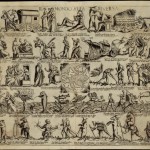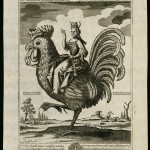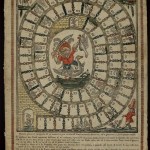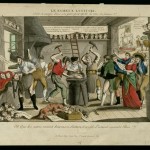
Spanning the fifteenth through the nineteenth centuries, the Ransom Center’s European popular imagery collection is now fully accessible online via two sources: the Center’s finding aid and ARTstor’s nonprofit digital library.
The Ransom Center’s online finding aid includes descriptive text derived from collector’s notes and a lengthy subject index. Each record in the finding aid also includes a link to the related image. ARTstor’s digital library provides advanced search functions and the ability to group selected images for PowerPoint display in classrooms, with images at high resolution.
The invention of the printing press in the fifteenth century and the resultant cultural phenomenon called “Popular Imagery” is a perfect example of cause and effect. Like printed words, unlimited reproductions of images helped bring about the development of a new visual language in early European society and a burgeoning cultural renaissance. The broad scope of the collection, whose origins include nine European countries, illustrate this fact. Prints make up the bulk of the popular imagery collection, with 686 intaglios (including 17 mezzotints), 115 woodcuts, one wood engraving, and six lithographs. Researchers will find an abundance of subjects, from political satire on kings, rulers, revolution, and war to social satire on gender, marriage, and domestic life; from religious studies and their allegorical themes on vice and virtue to numerous motifs on “The Ages of Man,” and “The Dance Macabre” or “Dance of Death.” Great moments in science and technology are visually well-represented in the collection, as are entertaining designs for buildings, board games, and signs of the Zodiac.
While some of the works in this collection were created anonymously—often to protect the creator from ridicule, incarceration, or worse—the collection also includes imagery by many significant artists of the time period, including Albrecht Dürer (1471–1528), Hans Holbein (1497–1543) and Lucas Cranach, the Younger (1515–1586).
Please click the thumbnails to view full-size images.


![Unidentified (German). Untitled [Satire on men's fashion], Late 17th century. Engraving and etching. Satirical broadside on imported men's fashions. Two dandies in elaborate costumes are shown shaking hands. Behind them, a bearded angel with a hourglass on his head is about to cut them down with his scythe.](https://sites.utexas.edu/ransomcentermagazine/files/2010/06/117-150x150.jpg)


![Gaspar Huberti (Belgian, 1619-1684). Untitled [The fight for the man's pants]. Hand-colored engraving. The eternal topic of the struggle for power between and among the sexes, and the question "who wears the pants" is one that provides occasion for humor as well as serious tensions.](https://sites.utexas.edu/ransomcentermagazine/files/2010/06/341-150x150.jpg)